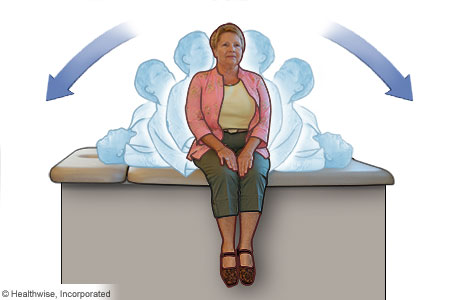Brandt-Daroff Exercise for Vertigo
Treament Overview
The Brandt-Daroff exercise is one of several exercises that can speed up the compensation process and end the symptoms of vertigo. It often is prescribed for people who have benign paroxysmal positional vertigo (BPPV) and sometimes for labyrinthitis. These exercises won't cure these conditions. But over time they can reduce symptoms of vertigo.
People who use this exercise usually are told to do several repetitions of the exercise at least twice a day.
How It Is Done

To do the Brandt-Daroff exercise:
- Start in an upright, seated position.
- Move into the lying position on one side with your nose pointed up at about a 45-degree angle.
- Remain in this position for about 30 seconds (or until the vertigo subsides, whichever is longer), then move back to the seated position.
- Repeat steps 2 and 3 on the other side.
What To Expect
Symptoms sometimes suddenly go away during an exercise period. More often, improvement occurs gradually over a period of weeks or months.
Why It Is Done
The Brandt-Daroff exercise and other similar exercises are used to treat BPPV. These exercises are sometimes used to treat labyrinthitis or vestibular neuritis.
How Well It Works
These exercises can help your body get used to the confusing signals that are causing your vertigo. This may help you get over your vertigo sooner.
The Brandt-Daroff exercise does not help relieve the symptoms of benign paroxysmal positional vertigo (BPPV) as well as the Semont manoeuvre or the Epley manoeuvre.footnote 1
Risks
There are no risks in doing these exercises. To avoid hitting your head or developing minor neck injuries, be careful not to lie down too quickly.
References
Citations
- Fife TD, et al. (2008). Practice parameter: Therapies for benign paroxysmal positional vertigo (an evidence-based review). Report of the Quality Standards Subcommittee of the American Academy of Neurology. Neurology, 70(22): 2067–2074.
Credits
Current as of: September 27, 2023
Current as of: September 27, 2023
Fife TD, et al. (2008). Practice parameter: Therapies for benign paroxysmal positional vertigo (an evidence-based review). Report of the Quality Standards Subcommittee of the American Academy of Neurology. Neurology, 70(22): 2067–2074.
